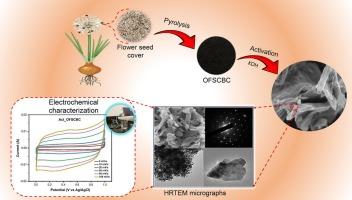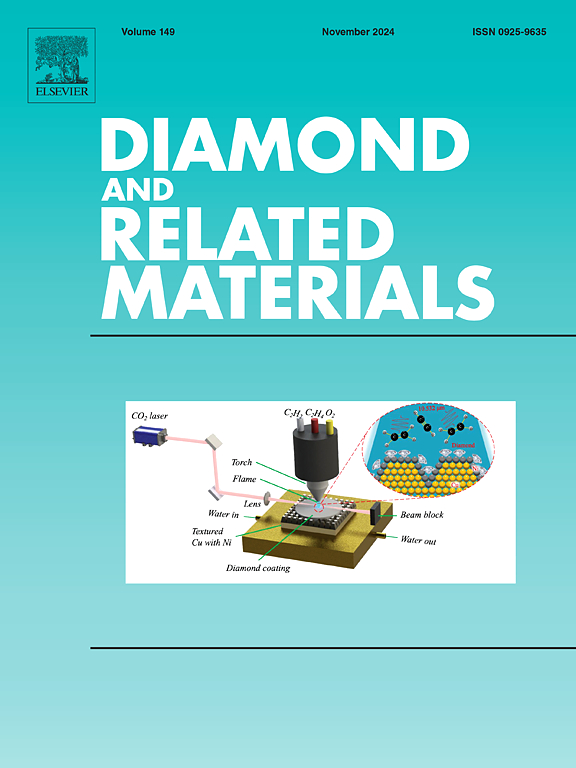用于高性能可持续超级电容器的新型洋葱花生物炭
IF 4.3
3区 材料科学
Q2 MATERIALS SCIENCE, COATINGS & FILMS
引用次数: 0
摘要
洋葱(学名 Allium cepa L.)通常被用作蔬菜,具有多种健康益处。然而,这项研究探索了洋葱植物的一个新部分,例如通常被视为废物的花籽覆盖层,通过热解将其转化为生物炭(BC)。经过精心优化和氢氧化钾活化,新型生物炭呈现出独特的石墨纳米片状结构,表面积高达 2538.31 m2/g。作为对照,最常用的生物质之一水稻秸秆也采用相同的方法进行活化。为了全面了解生物炭的表面和结构特性,我们采用了各种技术,包括 XPS、HRTEM、SAED、傅立叶变换红外光谱、BET、XRD 和拉曼光谱。将新型生物炭作为储能材料进行测试时,在三电极系统的 1 M H2SO4 电解质中,生物炭在 1 A/g 时的比电容为 200.37 F/g,在 5 A/g 时的比电容为 143.82 F/g。在双电极系统中,它在 1 A/g 和 5 A/g 时分别显示出 158 F/g 和 102 F/g,表明它在高速率下的有效性。长期循环稳定性分析表明,在三电极系统中,1000 次循环后的容量保持率为 100%;在双电极系统中,5000 次循环和 10,000 次循环后的容量保持率分别为 90.77% 和 74.40%。在电流密度为 1 A/g 时,所制造的对称超级电容器的功率密度为 500 W/kg,能量密度为 21.94 Wh/kg。这些发现为生物质的价值化提供了宝贵的见解,有助于解决目前能源存储的困境。本文章由计算机程序翻译,如有差异,请以英文原文为准。

Novel onion flower-derived biochar for high-performance sustainable supercapacitor applications
Onions, scientifically known as Allium cepa L., are commonly used as a vegetable and offer a variety of health benefits. However, this study explored a novel part of the onion plant, such as the flower seed cover often regarded as waste, by converting it into biochar (BC) via pyrolysis. Through careful optimization and activation with potassium hydroxide, the resulting novel biochar exhibited a unique graphitic nanosheet-like structure with an impressive surface area of 2538.31 m2/g. To serve as a control, rice straw, one of the most commonly used biomasses, was also activated using the same protocol. Various techniques, including XPS, HRTEM, SAED, FTIR, BET, XRD, and Raman, were used to comprehensively understand the surface and structural properties of the biochar. When the novel biochar was tested as an energy storage material, it exhibited a specific capacitance of 200.37 F/g at 1 A/g and 143.82 F/g at 5 A/g in a 1 M H2SO4 electrolyte with a three-electrode system. In a two-electrode system, it showed 158 F/g at 1 A/g and 102 F/g at 5 A/g, indicating its effectiveness at high rates. The long-term cyclic stability analysis demonstrated 100 % capacity retention over 1000 cycles in the three-electrode system, and 90.77 % and 74.40 % retention after 5000 cycles and 10,000 cycles, respectively, in the two-electrode system. The fabricated symmetric supercapacitor yielded a power density of 500 W/kg and an energy density of 21.94 Wh/kg at a current density of 1 A/g. These findings provide valuable insights into the valorization of biomass in addressing concerns regarding the current energy storage dilemma.
求助全文
通过发布文献求助,成功后即可免费获取论文全文。
去求助
来源期刊

Diamond and Related Materials
工程技术-材料科学:综合
CiteScore
6.00
自引率
14.60%
发文量
702
审稿时长
2.1 months
期刊介绍:
DRM is a leading international journal that publishes new fundamental and applied research on all forms of diamond, the integration of diamond with other advanced materials and development of technologies exploiting diamond. The synthesis, characterization and processing of single crystal diamond, polycrystalline films, nanodiamond powders and heterostructures with other advanced materials are encouraged topics for technical and review articles. In addition to diamond, the journal publishes manuscripts on the synthesis, characterization and application of other related materials including diamond-like carbons, carbon nanotubes, graphene, and boron and carbon nitrides. Articles are sought on the chemical functionalization of diamond and related materials as well as their use in electrochemistry, energy storage and conversion, chemical and biological sensing, imaging, thermal management, photonic and quantum applications, electron emission and electronic devices.
The International Conference on Diamond and Carbon Materials has evolved into the largest and most well attended forum in the field of diamond, providing a forum to showcase the latest results in the science and technology of diamond and other carbon materials such as carbon nanotubes, graphene, and diamond-like carbon. Run annually in association with Diamond and Related Materials the conference provides junior and established researchers the opportunity to exchange the latest results ranging from fundamental physical and chemical concepts to applied research focusing on the next generation carbon-based devices.
 求助内容:
求助内容: 应助结果提醒方式:
应助结果提醒方式:


